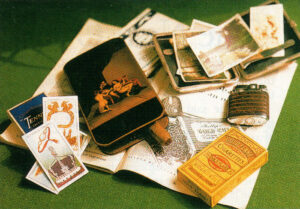
Most of us realise that smoking can damage your health – even those who continue to smoke! – yet in earlier times it was believed that tobacco had medicinal properties. Even as recently as the 1960s some doctors were advising non-smoking patients suffering with ‘nerves’ to smoke the occasional cigarette.
Back in the early part of this century snuff, a powder made from the grinding of tobacco leaves, was prescribed for nose bleeds and clearing the head, but snuff-taking lost lots of its prominence when cigar smoking became fashionable. This was later overtaken by the phenomenal popularity of cigarettes.
Smoking tobacco was also variously declared to act as a stimulus to the bowels, and to be a sedative. Physicians of the time warned, however, that in juveniles it could stunt their growth (an observation which could have been due to the large number of poor children seen roaming the streets and smoking). Many of these children were indeed of a small stature, although it’s more likely that lack of food rather than smoking was the root cause. Smoking would merely have helped them appease their hunger.
When society generally became a little more affluent children were still attracted by tobacco, not so much from smoking it as their interest in cigarette cards.
America was the first country to introduce these
cigarette cards, which were originally put into paper packets to act as stiffeners and protect the cigarettes from being crushed.
To the serious collector of cigarette cards, the golden age for quality was the first three decades of this century. The cards covered history, geography and almost every conceivable subject, from Atlantic liners to zoological studies. In the days before television, cigarette cards helped many children to broaden their
horizons.
Children also had another reason for collecting cards: They used them for playing games in the streets. The cards, often stuck together for added weight, would be flicked towards a wall or fence. The winner was the one whose cards landed nearest the obstruction, and he collected up the rest of the cards. Such amusements, along with ‘whips and tops’, have passed into history.
Many items associated with tobacco in the past have now become collectable – cigarette cases and boxes, cigar-cutters, ash trays and snuff boxes, the latter being particularly sought-after. These small canisters came from a variety of countries. Exquisite, hand-painted boxes were imported from China; from Tibet came others made from Yak horn, and from the West Indies boxes fashioned from shells.
Other collectable items are cigarette coupons. Some of the tobacco companies put them in their cigarette packets, and they were redeemable for gifts such as clocks, table lighters and a host of other things for the home. Many householders were thus able to acquire items that otherwise they would have been unable to afford.
Over the years smoking brought great pleasure to people oblivious to its health hazards, but through the memorabilia the tobacco industry generated, even non-smokers can look back on it with a certain amount of nostalgia.
Peter Pitt








